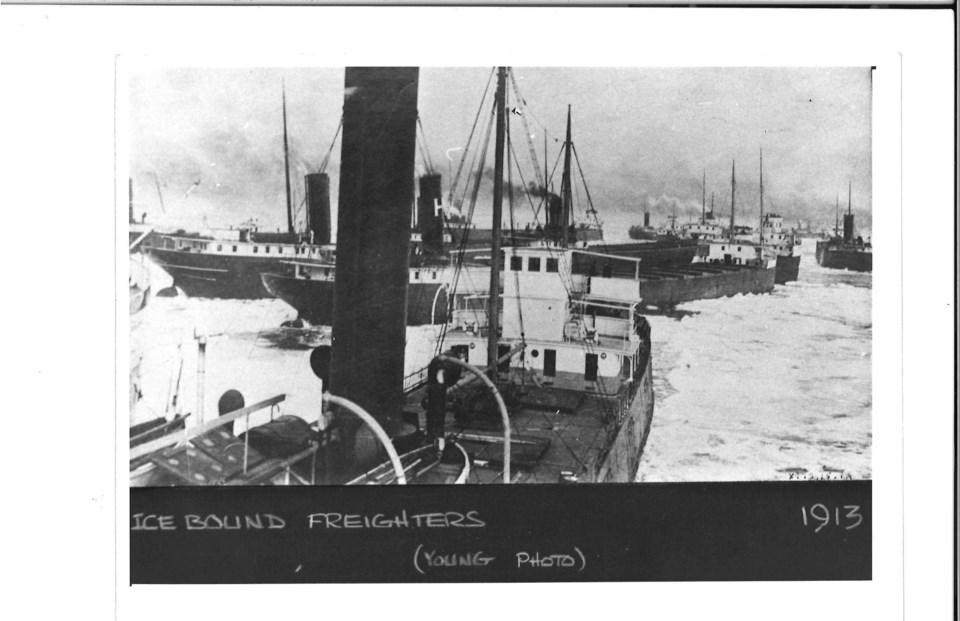From the archives of the Sault Ste. Marie Public Library:
The Great Lakes are a wonderful natural resource supplying fish, fresh water and a great place for boating and swimming during the summer. However, as winter approaches each year, the true power of the Great Lakes can make itself well-known in deadly ways.
During the first week of November 1913, the area was experiencing unseasonably warm weather; lulling people into thinking that winter was still a long way off. Temperatures were reported to be close to 80 degrees!
The captains of the ships going through the locks at Sault Ste. Marie on Thursday, Nov. 6 were congratulating themselves on their great luck in being able to make their journey in such good weather.
Unfortunately, weather conditions on Lake Superior can change rapidly and any vessel out on Lake Superior can find itself in big trouble very quickly.
Unknown to the sailors setting out into Lake Superior, on that November day in 1913, they were sailing into danger. A slow-moving Rocky Mountain low-pressure system was moving across the waters around Duluth, Minnesota. At the same time, a huge low-pressure system was moving rapidly down from Alaska.
The two low-pressure systems were on a collision course and eventually converged with each other with disastrous results for anything in its way.
By about 9 p.m. that Thursday evening, the E.H. Utley, which had locked through the Soo Locks earlier in the day, was moving through calm waters in Whitefish Bay. At 10 a.m. on Friday morning the U. S. Weather Bureau office in Duluth issued storm warnings.
Many ship captains, in an effort to complete as many voyages before the winter set in, ignored these warnings, however, believing that their ships were sound and able to withstand any kind of weather!
All-day Friday, the winds increased and the waves got rougher. By 6 p.m. on Friday night, the lake was so rough that the crew on the Utley had to eat their dinner standing up because the dishes wouldn’t stay on the table.
At midnight, the captain ordered the entire crew to go up on the deck to make sure that the hatch clamps didn’t loosen up in the wild weather.
The waves washed over the deck of the ship and then the snow began to fall as well. The snow was so heavy that they had zero visibility.
At one point another longboat crossed their bow so closely that the two ships missed each other by a matter of a few yards. Captain Fitch had no idea which ship actually crossed in front of them.
He later said, “There wasn’t anything I could do but watch . . . All I could do was hold onto the wheel and pray.”
The Alva C. Dinkey ended up on a direct course with the Alaskan storm and spent 23 hours fighting against the 30-foot waves. The captain then decided to turn the ship around, a dangerous manoeuvre in such rough waters, and try to run with the wind, instead of against it. The Dinkey fought the storm for another day and a half.
On Saturday, Nov. 9 at around 2 a.m., the Cornell was about 90 miles north of Whitefish Point and hit the storm, battling the wild winds and waves for 13 hours.
By late Saturday, the Cornell had been driven close to a beach. They dropped both anchors and by revving to full speed they were able to turn themselves around in the shallow water and spent the next 23 hours forcing the propellers to turn at full speed in an effort to keep the ship from being forced up onto the beach.
Once the wind and snow calmed down a bit, Captain Noble ordered the anchors back up and headed back out into open waters. Unfortunately, their troubles were not over yet.
At 5 a.m. on Monday, Nov. 10 a massive wave washed over the deck of the ship and tore away part of the after-cabin, breaking apart doors and windows, flooding the crew’s quarters and the galley.
By 10 p.m. on Monday night, the Cornell was finally able to steer itself into calmer waters – they had endured a 68-hour ordeal and survived to tell about it!
Click here for the second part of this article.
Each week, the Sault Ste. Marie Public Library and its Archives provides SooToday readers with a glimpse of the city’s past.
Find out more of what the Public Library has to offer at www.ssmpl.ca and look for more Remember This? columns here
